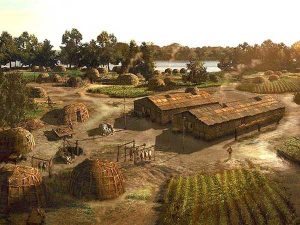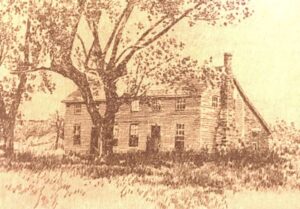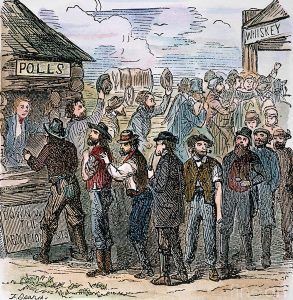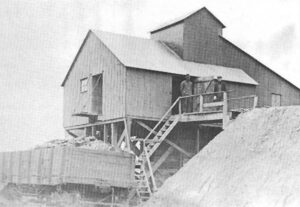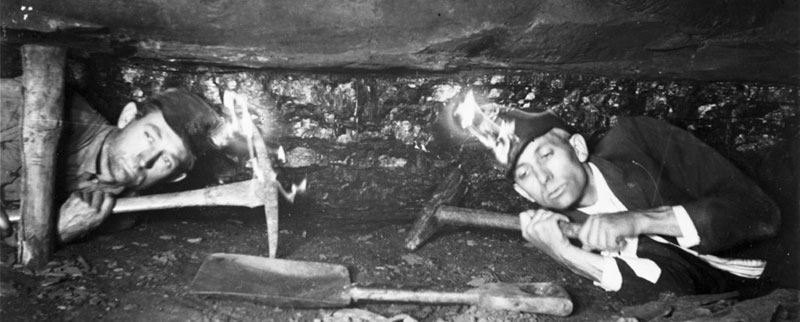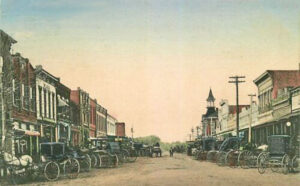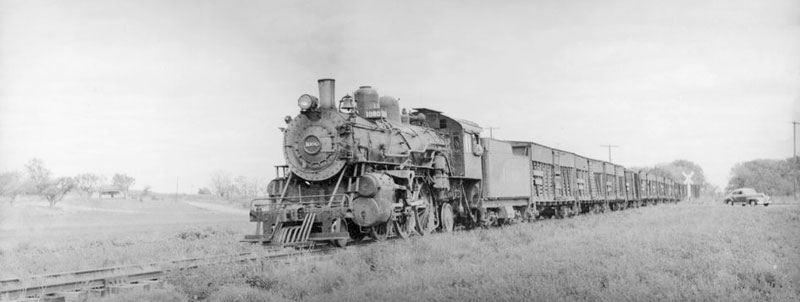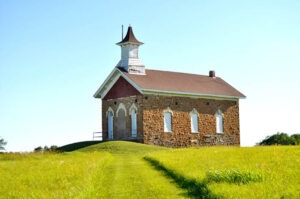Towns & Places:
Burlingame
Carbondale
Lyndon – County Seat
Melvern
Olivet
Osage City
Overbrook
Quenemo
Scranton
Vassar – Unincorporated
Melvern Lake & Eisenhower State Park
Pomona Lake State Park
Museums & Historic Sites
Osage County, Kansas, was created by the first territorial legislature in 1855 and was initially named Weller County. The county was named for Senator John Weller of California, a pro-slavery supporter.
It is the third county west of the Missouri line and centrally located between the Nebraska and Oklahoma state lines. It was not organized until February 1859, when the name was changed to Osage. It was changed because of the political leanings of the man it was first named for. Osage County was then named for the Osage Indian tribe.
The northern part of Osage County was formerly a part of the Shawnee Reserve, and the rest belonged to the Sac and Fox Indians. The main line of the Santa Fe Trail crossed the county from east to west, passing through the present city of Burlingame. The Leavenworth branch of this same road crossed the northern part.
The only white men living in the county before 1854 were General Whistler, an ex-army officer and Indian trader, and John Goodell, both of whom had married Indian wives and were living where the Santa Fe Trail crossed 110 Mile Creek, and a man by the name of Case, who kept a trading post at the Indian agency at Quenemo.
On May 30, 1854, John Frele settled with his family near Burlingame, where he bought out the land of a Shawnee Indian. His son, born shortly afterward, was the first white child born in the county outside of the agency.
In August, I. B. Titus, James and John Aiken, Alphonso Prentis, and others settled on Switzler Creek. Among these were John Skidmore, William Aiken, John Ward, Hollam Rice, Samuel Devany, and Harry Harvey, who settled on Dragoon Creek. At about the same time, the two McGee brothers, Fry P. and Mabillon bought out the two early settlers at 110 Mile Creek and established an inn. Moran McGee and C. N. Linkenauger took claims near the mouth of SwitzIer Creek.
In the fall, agents of the American Settlement Company selected a site for settlement not far from the present town of Burlingame. Among the colonists who came under the auspices of this company were George Bratton, Absalom W. Hoover, Joseph McDonald, James Bothel, William Cable, William Howard, Samuel Allison, J. R. Steward, Marcus J. Rose, and Thomas Black. Only 14 remained through the winter; the others, having no shelter or tools to build, returned east after staking their claims.
In 1855, the population was increased by significant immigration, the greater number settling near Council City and the others located along the creeks in various parts of the county.
The election troubles, familiar all over Kansas in 1855, were experienced in Osage County when the Missourians took the polls and elected their candidate, Mabillon McGee, to the legislature. Governor Andrew Reeder ordered another election, and a man named Rice received every vote in his district. A certificate of election was issued to Rice by the governor, but the legislature refused him a seat and admitted McGee in his stead.
Samuel Allison opened the first store in the county at Council City in 1855. The first post office was established about the same time with Loton Smith as postmaster and was kept at Allison’s store. The first July 4 celebration was held the same year. The first marriage of record took place in 1860 between John Riffenback and Hannah Thompson. The first school was supported by subscription and was taught in a tent in the spring of 1855 by Miss Louisa Todd. The year 1856 was a severe one for the settlers. Nearly everyone was sick with malarial fever. Sufficient and suitable food was impossible to obtain, and this, together with a lack of medical aid and proper care, resulted in many deaths, including that of Loton Smith.
Most of the claims were taken before the government surveys were done, and each settler staked out as nearly as possible 240 acres. This gave rise to considerable trouble as only 160 acres were allowed by the government. When the surveys were completed, farms were cut into all shapes, and the ownership of the various pieces was hard to determine. To add to the trouble, many residents could not buy the lands they occupied when the government put them up for sale in 1859. They were obliged to borrow money, which they could not pay interest, and finally lost their holdings. The drought of 1860 reduced the settlers to starvation, and when they finally did raise crops, there was no market for them. In 1859 and again in 1861, the county was swept by severe storms that destroyed considerable property, injured several people, and caused great suffering.
Coal was discovered near Carbondale in about 1860, influencing the development and route of the Atchison, Topeka & Santa Fe Railroad. However, production did not occur until at least 1867, when a strip mine was developed near Scranton. The discovery of coal early in 1869 by John F. Dodds at Carbon Hill was the catalyst that led to a rapid increase in mining activity. That year, several mines were opened in Osage City and at Carbondale, and shortly after that, development began at Scranton. Mining was delayed at Burlingame until 1897 because the coal was considerably deeper, and many felt it did not exist.
Before the railroad’s arrival, the market area for Osage coal was quite restricted. Coal at that time was hauled exclusively by wagon, and the market probably did not extend beyond a radius of 40 miles from the mining areas.
In 1869, the Santa Fe railway penetrated Osage County’s coalfield and continued westward.
At this time, Osage coal was marketed in a narrow belt virtually across the entire length of the state. No significant competition had been met in the west because the railroad had not yet tapped the Colorado fields of Trinidad and Canon City. The strongest competition was found in Bourbon County. Coal mining coal greatly stimulated the growth and development of the county. By 1871, the coalfields became the leading coal mine center in the state.
In the following years, more coal fields were developed in other areas of the state and country that were cleaner to burn with less sulfur content, which caused coal production to decline after the turn of the century rapidly. The last shaft mine in the state, south of Burlingame, Bell Mine #4, closed in 1964. However, the coalfields of Osage County continued to be the prime source of energy for the Santa Fe Railroad with its deployment to the West Coast and other areas.
In common with the whole state, Osage County suffered from the devastations of the grasshoppers in 1866 and 1874.
The county seat contest, common to nearly all new counties, took on a serious aspect in Osage County. Before the organization of the county, voting took place in Burlingame, and no objections were raised. The first meeting of the county commissioners on April 27, 1859, was held at Superior. On June 7, officers were elected. The legislature of 1860 appointed a commission to select a location for the county seat. They selected a spot about midway between Superior and Burlingame, which they called Prescott. Prescott was rejected at the county seat election, held in April, and Superior continued as the county seat. The first term of the district court was held there in October 1861.
A county seat election was held in 1861, and another in 1862, and both resulted in the choice of Burlingame, where the county records remained for many years. When the Indians moved away and the whole of the county was opened to settlement, Burlingame was not central enough. Another county seat election was called in October 1870, resulting in a victory for Lyndon. The Burlingame people immediately got an injunction to prevent the removal of the county records, which was the beginning of a series of litigation and strife in 1875, with both sides resorting to the use of arms.
The people of Lyndon, who had been trying to get the county records for five years, finally decided to resort to force, and a small body of armed men with a team was sent to Burlingame to remove the records. On learning of their approach, the men of Burlingame barricaded the courthouse and prepared to defend it. Scouts were stationed along the road to guard it. The Lyndon men sent out scouts one or two at a time to inspect, all of whom were captured and landed in jail. A force of about 400 from the southern part of the county was then raised at Lyndon and marched to Burlingame, determined to secure the records or burn the town. Scouts sent on ahead brought back the intelligence that the courthouse was filled with armed men ready to defend the records. For a time, it appeared as though there would be a battle, as both sides were worked up to a fury. However, wiser counsel on both sides prevailed, and Burlingame gave up the records, believing that to be the only way to save the town from destruction. A short time after this, the Supreme Court, in which the case was pending, sustained the lower court in favor of Lyndon, and the county seat has remained there ever since.
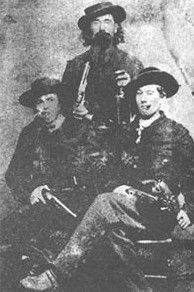
Missouri Border Ruffians.
The first military company was organized in 1855 to march to the defense of Lawrence. It was called the “Old Free State Guards.” The following year, border troubles began in Osage County, which did not end until after the Civil War. The free soilers organized another military company in June 1856. A portion of Buford’s company, sent from the southern states to drive the anti-slavery men out of Kansas, camped on 110 Mile Creek, where they remained all summer, making raids, robbing, and committing various outrages. Travel on the Santa Fe Trail was seriously impeded, and getting provisions into the free-state settlements was impossible unless an armed force protected the wagons. On July 4, nearly every man in the settlement went to Topeka to prevent the border ruffians from attacking the free-state legislature, which was to convene that day. On its being dispersed by Colonel Sumner, they returned home.
Most of the new immigration was free-state, and by the time the Civil War broke out, Osage County was overwhelmingly opposed to slavery. During that conflict, Osage County furnished more than its share of soldiers for the Union army. The first enlistment was in May 1861, when 25 men entered the Second Kansas Infantry. Many Osage County men served in the Eleventh Kansas, and many joined the regiments of other states. During the Price Raid, every able-bodied man in Osage went to the defense of the border. They composed the Santa Fe Road Battalion and were commanded by Colonel M. M. Murdock. The loss of life among Osage County men during that campaign was heavy.
In 1865, two bonding propositions far railroads were carried in Osage County — one for the Lawrence & Emporia and the other for the Atchison, Topeka & Santa Fe Railroad. The farmer was never built, but the latter was completed through the county in 1869 when $150,000 in bonds were issued. The following year, the Lawrence & Carbondale Railroad was built. Various other railroads were projected in the succeeding years, but no more were built until 1879 when the Manhattan, Alma & Burlingame Railroad was completed.
The surface of Osage County is an undulating prairie. In the early years, coal of excellent variety was found underlying a large portion of the county. It was mined at Osage City, Scranton, Carbondale, Burlingame, and other points. Magnesian limestone was found in the east, blue and gray limestone in the west, and superior quality sandstone in the north. Some flagging stone quarried at Osage City was used in paving in Topeka and Emporia. A gray marble capable of taking a high polish was found in the southern townships. There were salt springs in the south along Salt Creek and a mineral spring near Carbondale that was said to possess medicinal qualities.
In 1910, there were 140 miles of railroad in the county. Corn, oats, oats, and wheat were leading crops, and livestock was a leading commodity. At that time, the county population was 19,905.
For many years, the major economic forces in Osage County were coal mining, railroading, and farming. As the coal fields were depleted, the railroads followed suit. Farming remains and is supplemented with recreation as Pomona Lake and Melvern Lake are in the county.
As of the 2020 census, the county population was 15,766.
Interesting sites in the county include the Mission Covenant Church, the Arvonia School, the Quenemo Opera House, the Melvern Stone School, the Methodist Mission Building, and the Osage City Santa Fe Railroad Depot.
© Kathy Alexander/Legends of Kansas, updated October 2023.
Also See:
Sources:
Blackmar, Frank W.; Kansas: A Cyclopedia of State History, Vol I; Standard Publishing Company, Chicago, IL 1912.
Cutler, William G; History of Kansas; A. T. Andreas, Chicago, IL, 1883
Kansapedia
Kansas Historical Society
Osage County




